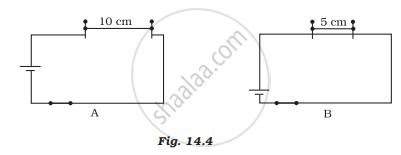Advertisements
Advertisements
प्रश्न
Which metal is used to make the filament of an electric bulb?
उत्तर
Tungsten metal is used to make the filament of an electric bulb.
APPEARS IN
संबंधित प्रश्न
Name any two effects of electric current.
Give two reasons why nichrome alloy is used for making the heating elements of electrical appliances.
An electric kettle rated at 220 V, 2.2 kW, works for 3 hours. Find the energy consumed and the current drawn.
How much heat will an instrument of 12 W produce in one minute if it is connected to the heat produced by it?
The current passing through a room heater has been halved. What will happen to the heat produced by it?
If the current flowing through a fixed resistor is halved, the heat produced in it will become:
How does the wire in the filament of a light bulb behave differently to the other wires in the circuit when the current flows?
What property of the filament wire accounts for this difference?
Why does tungsten metal used to make solenoid type coil in an electric bulb?
Solve the following question.
Compute the heat generated while transferring 96000 coulombs of charge in two hours through a potential difference of 40 V.
The electricity bill specifies the usage in _______.
What is the heating effect of electric current?
What is a short circuit?
What is overloading?
Write two devices based on the heating effect of electric current.
What does overloading cause?
Name any two appliances which work under the principle of heating effect of current.
Which of the following is correct?
An electric iron consumes energy at the rate of 420 W when heating is at the maximum rate and 180 W when heating is at the minimum rate. The applied voltage is 220 V. What is the current in each case?
How does use of a fuse wire protect electrical appliances?
Why is parallel arrangement used in domestic wiring?
Unscramble the following words:
SFEU
Can we use the same fuse in a geyser and a television set? Explain.
Your teacher has shown you the following activity.

Activity: The teacher has wound a long insulated piece of wire around an iron nail in the form of a coil. The free ends of the wire are connected to a cell through a switch as shown in Figure 14.3. The current is switched on and some pins are placed near the ends of the nail.
Write down any three questions that come to your mind about this activity
Paheli took a wire of length of 10 cm. Boojho took a wire of 5 cm of the same material and thickness. Both of them connected the wires as shown in the circuit given in Figure 14.4. The current flowing in both circuits is the same.
(i) Will the heat produced in both cases be equal? Explain
(ii) Will the heat produced be the same if the wires taken by them are of equal lengths but of different thicknesses? Explain.

An MCB can be used instead of a fuse in an electrical circuit.
An electric fuse has a body made of ceramic and two points for connecting the fuse wire.
______ wire is used in the filament of the bulbs.
Copper wire offers very little ______ and does not get heated up quickly.
Match the following
| 1. | Bulb | a. | Conductor |
| 2. | Electroplating | b. |
Insulator |
| 3. | Pure water | c. | Heating effect of current |
| 4. | Salt solution | d. | Chemical effect of current |
Name the effect of the current responsible for the glow of the bulb in an electrical circuit.
Name a few appliances which work on the basis of the heating effect of current.
A student boils water in an electric kettle for 20 minutes. Using the same mains supply he wants to reduce the boiling time of water. To do so should he increase or decrease the length of the heating element? Justify your answer.
Define the following:
Electrolysis and electrolyte
1 kWh is equal to ______.
